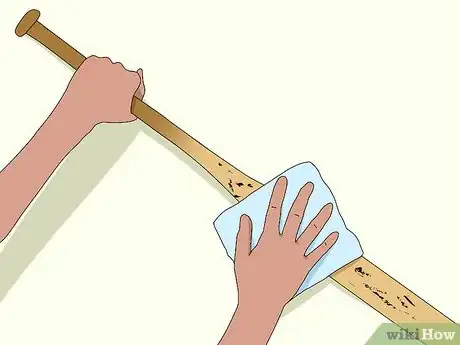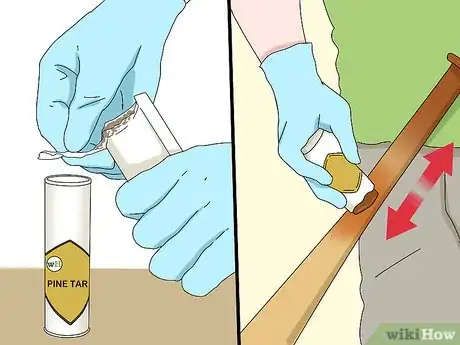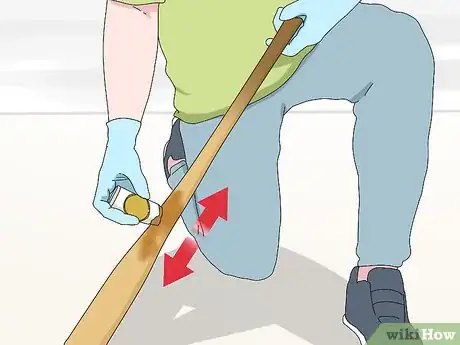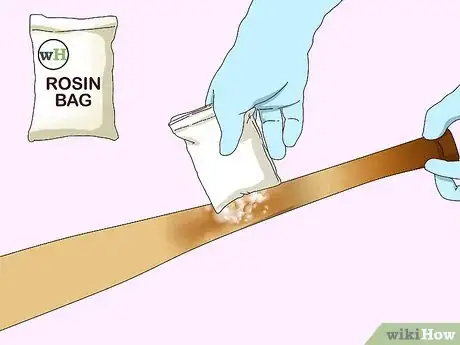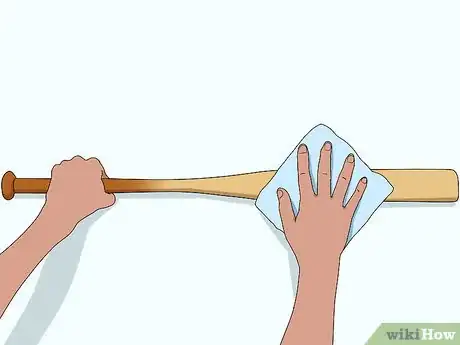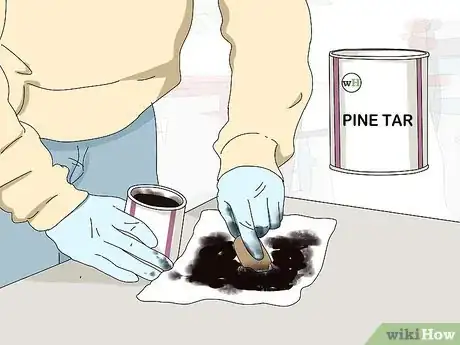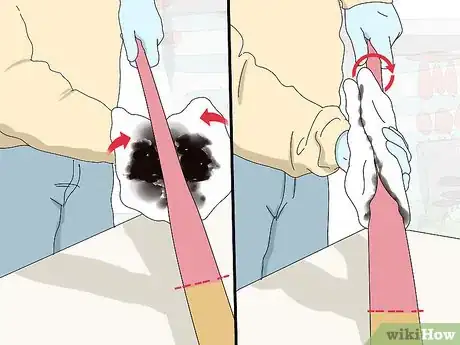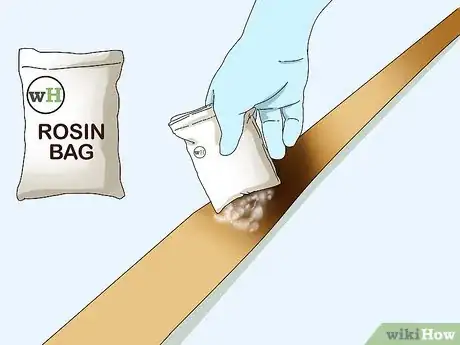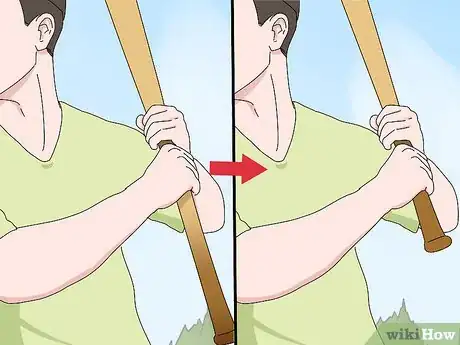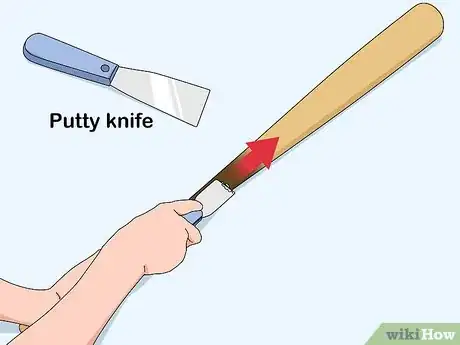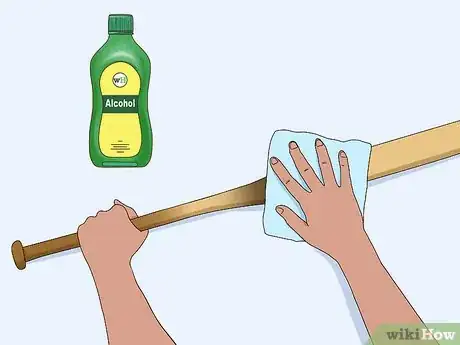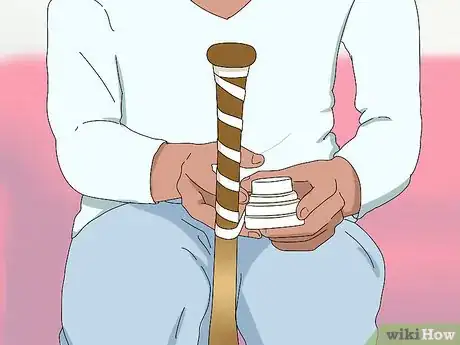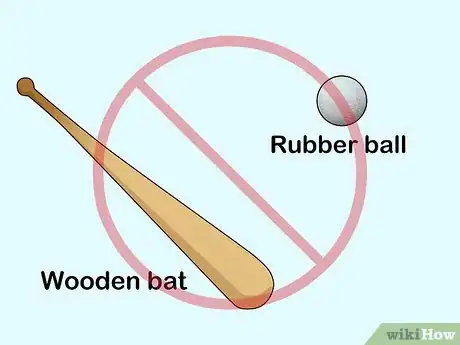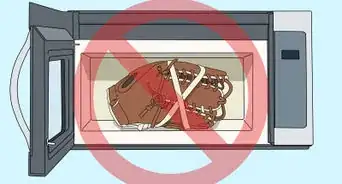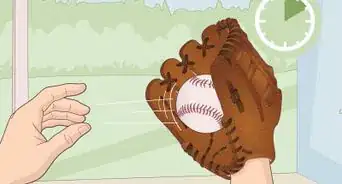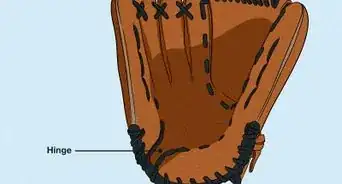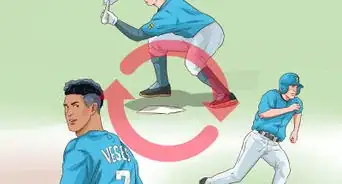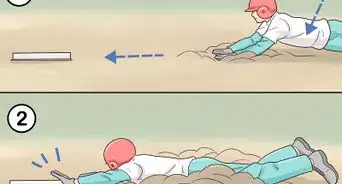This article was co-authored by wikiHow Staff. Our trained team of editors and researchers validate articles for accuracy and comprehensiveness. wikiHow's Content Management Team carefully monitors the work from our editorial staff to ensure that each article is backed by trusted research and meets our high quality standards.
There are 12 references cited in this article, which can be found at the bottom of the page.
This article has been viewed 15,625 times.
Learn more...
If you have trouble keeping a grip on the handle of your wooden bat, some pine tar might be just the thing to improve your swing. Pine tar can be applied directly to bat handles or to the mid-bat, depending on your preference. It comes in stick and liquid form, but whichever you choose, it’s relatively easy to apply.
Steps
Using a Pine Tar Stick
-
1Wipe away debris from the bat. Any turf or dirt already on your bat will likely get stuck in the pine tar. This can negatively impact the stickiness of the tar and appearance of the bat, so it’s best to wipe away any visible dirtiness with a clean, dry rag.
- If your bat has difficult to remove buildup or scuff marks, wet your cleaning rag with a little bit of rubbing alcohol.[1]
-
2Uncap the pine tar and rub it on the bat’s handle. Pine tar sticks hold pine tar in a plastic casing. Take the lid off the stick and rub the tar onto the handle of your bat. Rub it up and down in an overlapping pattern, turning the bat a little at a time as you do so to completely coat the handle.[2]
- Pine tar is less likely to get on your hands when using it in stick form, but to avoid accidentally transferring it somewhere else, wear plastic gloves while applying it to the bat.
Advertisement -
3Apply pine tar to the mid-bat, alternatively. This is the preferred area to apply pine tar if you don’t like the handle of your bat getting excessively sticky. Uncap the pine tar and rub it up and down on the barrel of the bat beneath the label. Turn the bat as you apply the tar to coat the barrel completely.[3]
- When you feel like you need more stickiness on the bat’s handle, tap your hand against the barrel and then back on the handle to transfer a little bit of tar to the handle at a time.
- Avoid applying pine tar onto or beyond the bat’s label. Most baseball leagues have rules against applying tar this far up the bat.[4]
-
4Pat the pine tar with a Rosin bag. Pure pine tar, when applied to your bat, will be sticky, but also a little bit slick. This can work against you if you don’t have some grittiness to give your hands a better purchase. Patting pine tar lightly with a rosin bag will add this grittiness.[5]
- When applying a rosin bag, use only a little bit at a time. You can always add more, but to remove grittiness, you’ll likely have to clean off the entire bat.
Applying Liquid Pine Tar with a Rag
-
1Clean the surface of your bat. Clean your bat as you would normally when applying pine tar. Use a dry rag to remove debris and dirt. Scuff marks, old pine tar, or other difficult to remove blemishes can usually be removed with a little bit of rubbing alcohol.[6]
-
2Apply pine tar to a rag. Open the top of your pine tar and set it carefully off to the side. Scoop out the thick, gooey pine tar from the container onto the middle of the rag. The pine tar should be relatively thick and spread over an area on the rag about the size of your hand.[7]
- If your pine tar didn’t come with an applicator, use a rigid piece of scrap plastic or wood instead. A sturdy plastic spoon, for example, might work well.
- Because liquid pine tar tends to spread easily, you may want to wear latex gloves so it doesn't get on your hands.
-
3Roll the bat in the rag to apply pine tar at the bat middle. Pick up the towel and hold it with the pine tar side up. Place the barrel of the bat into the pine tar so the tar comes to the area just below the bat’s label. Enclose the bat in the towel, then roll the bat to spread the tar on the barrel.[8]
- Be careful not to spread the pine tar farther up the barrel of the bat than the label. Doing so will likely be a violation of your league rules for pine tar application.[9]
- Pine tar will apply most easily to bats with a rough or textured surface. Bats with a smooth surface may require a second application of tar. Wait about 24 hours between applications.[10]
-
4Add grittiness to the pine tar with a rosin bag. Some grit in the pine tar will allow your hands to grip even better. Lightly tap a rosin bag against the areas you have applied pine tar. Less is better than more. You’ll be able to add more grit easily, but the same isn’t true the other way around.[11]
-
5Transfer the tar from the mid-bat to the handle. When you feel like the bat handle could use some additional stickiness, transfer it from the mid-bat to the handle with your hands. Simple tap your hands one at a time against the pine tar, return them to the handle, and you’re ready to swing.[12]
Maintaining Your Bat
-
1Scrape off old pine tar with a putty knife. When pine tar picks up bits of dirt and turf, it can become excessively gritty and lose its stickiness. Take a putty knife (or a similar tool) and scrape the hardened pine tar from the handle of your bat.[13]
- As the pine tar scrapes away, it will fall off in bits and pieces, making quite a mess. Make cleanup easier by covering your work area with a layer of newspaper or a drop cloth.
- It’s best to remove old pine tar completely before adding a new layer, otherwise impurities can spread from the old to the new.
- Fine-grit sandpaper is useful for taking off stubborn tar. Lightly sand areas with stubborn tar until the wood is clean and smooth to the touch.[14]
-
2Clean your bat periodically. When your bat is caked with sweat, dirt, and pine tar, it’s time for a cleaning. Use a clean rag to apply rubbing alcohol to the bat and wipe away the dirtiness.[15]
- This process will be easiest if you scrape away excess pine tar and peel off tape first.[16]
- For improved cleaning power, use a specially formulated compound for cleaning bats, like Goo Gone or CleanUp Batter.
- Some cleaners may be harsh on your skin. Always follow the label instructions of cleaning products for the best results, and wear latex gloves when necessary.
-
3Tape your bat. There are many different taping patterns you might use on your bat. The pattern you use is a matter of preference, so you might want to try a few different styles before settling on a favorite. Tape can be used in combination with pine tar to improve your grip even more.[17]
- One of the most popular ways of applying athletic tape is by rolling it around and up the handle of the bat at a 45° angle. Leave thin gaps in the tape to improve the grip.[18]
- Unless it makes the grip uncomfortable, use two layers of tape. Like the first layer, use an upwards 45° angle, but fill in gaps left in the first layer with the second.[19]
- Generally, baseball leagues limit how far tape is allowed to travel up the neck of the bat. Look up your league rules and mark the bat with a permanent marker at the maximum allowed tape length.
-
4Refrain from using wooden bats with rubber balls. Specifically, you’ll want to avoid the rubber balls used in batting cages. These will chip away at the life of your bat, causing it to crack or shatter much more quickly than it would naturally.
- When practicing, it’s a good idea to tape the barrel of your bat. This will drastically lower the chances of your bat breaking.[20]
Warnings
- Pine tar is quite thick and dark, so it can easily stain your carpeting or clothing. You may want to apply tar while wearing disposable gloves to prevent it from transferring from your hands to other surfaces.⧼thumbs_response⧽
Things You’ll Need
Using a Pine Tar Stick
- Clean rag
- Pine tar stick
- Rosin bag
- Rubbing alcohol (optional)
Applying Liquid Pine Tar with a Rag
- Liquid pine tar
- Rag
- Rosin bag
- Scoop (like a plastic applicator)
- Rubbing alcohol (optional)
Maintaining Your Bat
- Athletic tape (or medical tape)
- Putty knife
- Rosin bag
References
- ↑ http://protips.dickssportinggoods.com/sports-and-activities/baseball/get-wood-baseball-bat
- ↑ https://www.youtube.com/watch?v=iBUFCSv4yTQ&feature=youtu.be&t=45s
- ↑ https://www.youtube.com/watch?v=iBUFCSv4yTQ&feature=youtu.be&t=49s
- ↑ https://www.youtube.com/watch?v=v6I8Jsa-Y50&feature=youtu.be&t=1m
- ↑ https://www.youtube.com/watch?v=iBUFCSv4yTQ&feature=youtu.be&t=1m
- ↑ http://protips.dickssportinggoods.com/sports-and-activities/baseball/get-wood-baseball-bat
- ↑ https://www.youtube.com/watch?v=v6I8Jsa-Y50&feature=youtu.be&t=31s
- ↑ https://www.youtube.com/watch?v=v6I8Jsa-Y50&feature=youtu.be&t=50s
- ↑ https://www.youtube.com/watch?v=v6I8Jsa-Y50&feature=youtu.be&t=1m
- ↑ https://www.youtube.com/watch?v=v6I8Jsa-Y50&feature=youtu.be&t=1m27s
- ↑ https://www.youtube.com/watch?v=iBUFCSv4yTQ&feature=youtu.be&t=1m1s
- ↑ http://protips.dickssportinggoods.com/sports-and-activities/baseball/get-wood-baseball-bat
- ↑ https://www.youtube.com/watch?v=1efagyDrwII
- ↑ http://healthyliving.azcentral.com/tape-up-handle-wooden-bat-8003.html
- ↑ http://protips.dickssportinggoods.com/sports-and-activities/baseball/get-wood-baseball-bat
- ↑ https://www.youtube.com/watch?v=1efagyDrwII
- ↑ http://protips.dickssportinggoods.com/sports-and-activities/baseball/get-wood-baseball-bat
- ↑ http://healthyliving.azcentral.com/tape-up-handle-wooden-bat-8003.html
- ↑ http://baseballeagle.com/how-to-tape-a-baseball-bat/
- ↑ http://protips.dickssportinggoods.com/sports-and-activities/baseball/get-wood-baseball-bat
